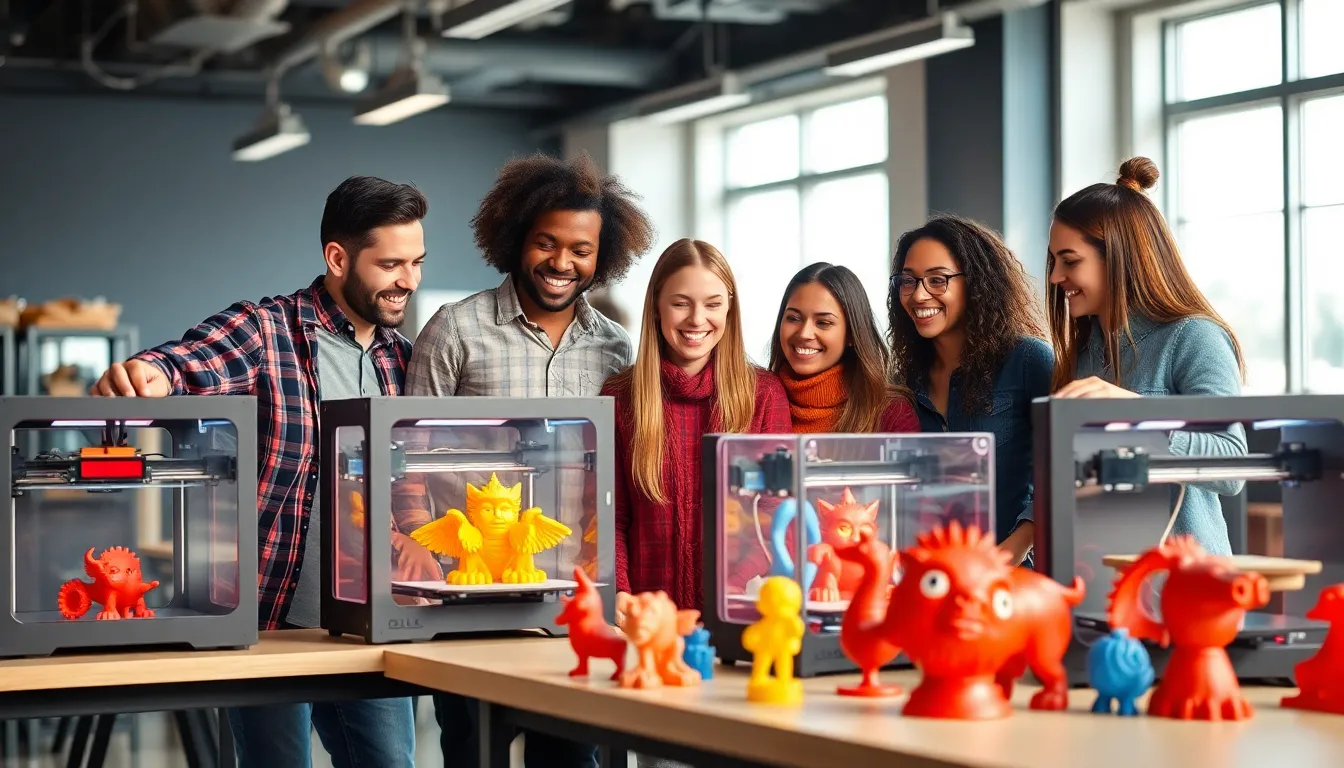In the ever-evolving world of technology, 3D printing stands out as a revolutionary force, transforming how ideas become tangible products. As more enthusiasts and professionals dive into this innovative field, finding the right resources online is crucial. 3D printer websites offer a wealth of information, from buying guides to design files, catering to both beginners and seasoned users alike.
Navigating this digital landscape can be overwhelming, but knowing where to look makes all the difference. The best 3D printer websites not only provide high-quality printers and materials but also foster a vibrant community of creators. Whether someone’s looking to print a prototype or a unique piece of art, these platforms are essential for unlocking the full potential of 3D printing.
Table of Contents
ToggleOverview of 3D Printer Websites
3D printer websites serve as vital resources for enthusiasts and professionals. These platforms provide essential information, including comprehensive buying guides, detailed reviews, and user-generated design files.
Types of Resources Available:
- Buying Guides: Help users select the right printer based on specific needs, such as budget and intended use.
- Design Files: Offer a variety of downloadable models created by users, catering to diverse interests like toys, functional parts, and art.
- Community Forums: Facilitate discussions among users, enabling them to share experiences and solutions to common problems.
Key Features of 3D Printer Websites:
- Educational Content: Tutorials and articles that explain the basics of 3D printing technology and techniques.
- Print Settings: Recommendations for optimal print settings, enhancing quality and efficiency in projects.
- User Support: Access to support through forums or direct customer service, assisting users with troubleshooting and best practices.
Benefits of Engaging with These Websites:
- Inspiration: Users discover new ideas and innovative projects from shared designs.
- Collaboration: Opportunities for collaboration and networking within the community encourage knowledge sharing.
- Updates: Regular news on industry advancements, product launches, and software updates keeps users informed and competitive.
3D printer websites play a crucial role in enhancing the user experience by providing access to valuable resources and building a supportive community for all things 3D printing.
Top 3D Printer Websites to Consider

Several websites excel in providing resources for 3D printing enthusiasts. Each offers unique features that cater to different needs, ensuring users can find the right support and inspiration.
Website 1: Features and Benefits
Thingiverse
- User Community: Thingiverse hosts a vast community of creators who share their 3D models, making it easy to find designs across various categories.
- Design Repository: The extensive library includes thousands of user-generated designs, accessible for free.
- Customization Tools: Users can modify designs directly on the site, facilitating customization before printing.
- Educational Content: Thingiverse offers guides and tutorials that aid both beginners and experienced users in enhancing their 3D printing skills.
Website 2: Features and Benefits
MyMiniFactory
- Quality Assurance: MyMiniFactory collaborates with designers to ensure every model meets strict quality standards before publication.
- Marketplace for Creators: Users can sell their designs, providing creators with a platform to monetize their work.
- Curated Collections: The website features curated collections that highlight trending and unique designs.
- Print Compatibility Checks: Users can verify whether their 3D printer can handle specific models, preventing compatibility issues.
Website 3: Features and Benefits
- Diverse Design Ranges: Cults3D caters to various interests, from cosplay to functional parts, offering a rich selection of models.
- Community Engagement: Users can interact through comments and ratings, fostering collaboration and feedback within the community.
- Paid and Free Designs: The platform offers both free and paid designs, giving users options based on their budget.
- Designer Support: Cults3D promotes designers through features, increasing their visibility while offering tips for improved model creation.
Comparing 3D Printer Websites
Evaluating 3D printer websites involves several factors including pricing, user experience, and customer support. These elements significantly influence user engagement and satisfaction.
Pricing and Affordability
Comparative pricing among 3D printer websites reveals diverse strategies. Thingiverse offers free access to thousands of designs, attracting budget-conscious users. MyMiniFactory provides a mix of free and paid models, with prices typically ranging from $1 to $20, ensuring users receive high-quality, verified files. Cults3D employs a marketplace model that features average design prices between $2 and $25, catering to creators looking for unique project files. Users benefit from these varied pricing structures, allowing them to select options that fit their budgets while accessing valuable resources.
User Experience and Navigation
User experience plays a critical role in website effectiveness. Thingiverse excels in its straightforward interface, allowing users to easily browse through categories and search functions. MyMiniFactory enhances navigation with filtered searches and organized collections, which streamline the design-finding process. Cults3D balances aesthetics with usability, ensuring users can quickly navigate between free and paid designs. A positive user experience promotes engagement, making it simpler for creators to discover and share innovative projects.
Customer Support and Community
Customer support and community engagement vary significantly among 3D printer websites. Thingiverse fosters a vibrant community through forums and user feedback, where members can share tips and ask questions. MyMiniFactory invests in community support with direct help channels and active forums, promoting creator collaboration. Cults3D encourages interaction through comments and ratings on designs, alongside a responsive support team. Comprehensive customer support strengthens community bonds and enhances the overall user experience, encouraging continued participation and learning.
Trends in 3D Printing Websites
3D printing websites reflect dynamic technological advancements and user needs. Key trends include increased customization options, integration of augmented reality (AR), and a surge in educational content aimed at beginners and experts.
- Customization Options
3D printing websites increasingly feature tools that allow users to customize designs easily. These tools enable adjustments in dimensions, textures, and colors, enhancing user creativity. Sites like Thingiverse and MyMiniFactory offer various customization features, encouraging unique creations tailored to personal preferences.
Many platforms are adopting augmented reality to enhance user experience. Users can visualize designs in real-time within their environment before printing. This trend allows for more informed decisions regarding design selection and spatial considerations.
- Focus on Educational Content
Educational resources are expanding, providing tutorials, webinars, and guides that address diverse skill levels. Websites are publishing comprehensive articles on optimal printing techniques, 3D modeling software, and troubleshooting, assisting users in overcoming common challenges.
- Sustainable Practices
There’s a growing emphasis on sustainability within the 3D printing community. Websites are promoting eco-friendly materials and responsible printing practices. Some platforms highlight designs created with recycled materials, encouraging users to adopt greener habits in their projects.
- Community Engagement
Community-driven features are becoming essential for 3D printing websites. User forums, rating systems, and comment sections foster interaction among users. Platforms like Cults3D emphasize community feedback, allowing designs’ continuous improvement based on user experiences.
- Marketplace Evolution
The marketplace functions on these websites are evolving. Users increasingly seek not just free resources but are also willing to invest in high-quality designs. Platforms like MyMiniFactory excel in curating collections of premium designs while ensuring quality through extensive review processes.
These trends highlight the evolving landscape of 3D printing websites, where user experience, creativity, and sustainability play central roles in shaping future innovations.
Navigating the world of 3D printing websites opens up a realm of possibilities for enthusiasts and creators alike. By leveraging the resources offered on these platforms, users can enhance their skills and creativity while staying informed about the latest industry trends.
With a variety of options available, including user-generated designs and educational content, individuals can find the right fit for their needs. Engaging with these communities not only inspires innovation but also fosters collaboration among users.
As the landscape of 3D printing continues to evolve, these websites will remain essential tools for anyone looking to explore the full potential of this transformative technology.




